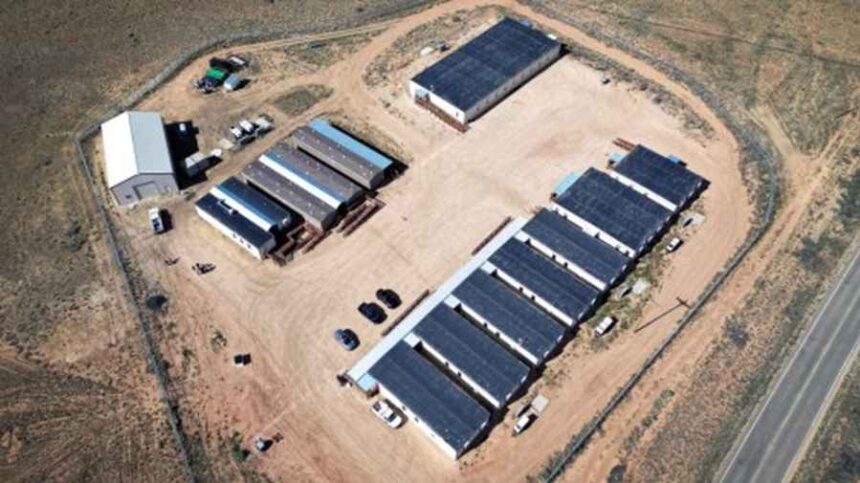Thanks to the continued AI boom, data centers are popping up around the U.S., but some states are favored more than others. While Virginia has the most data centers, over 300, Arizona is now a magnet for new facilities, given its low operating costs and plentiful space.
There are, of course, additional logistical hurdles involved in keeping data center racks cool in the parched desert. A 2024 report by the Electric Power Research Institute found that data centers in Arizona could consume up to 16.5% of the state’s total electricity. And Arizona’s largest utility, APS, reports that the growth in energy demand from data centers is occurring at a rate 100 times faster than for all other customer types. This could lead to increased utility costs and grid instability for residents.
Solving unreliable power access
The Hopi Reservation in northeastern Arizona exists on the edge of the power grid. While a data center is not responsible for the reservation’s energy problems, the solution could be applied to communities that are experiencing energy issues due to a data center.
Researchers, engineers and community leaders met at the future site of the Hopi Nation Community Solar Project on the Hopi Reservation. The project will adapt existing infrastructure to support a hybrid solar microgrid to provide energy to the community. Credit: Image courtesy Kristen Parrish, ASU
The Turquoise Trail administration campus currently relies on generators to keep buildings operational for a few hours a day. The clear need for a solution prompted a collaboration between Arizona State University, the Hopi Utilities Corporation and BoxPower to design a solar-powered microgrid that can serve as a replicable blueprint for rural energy resilience.
The project is backed by a $9 million grant from the Energy Improvements in Rural or Remote Areas program through the U.S. Department of Energy.
The microgrid will power 15 buildings on the Turquoise Trail Municipal Complex, which provides essential services to the community. Researchers on the project say the energy issues faced by the Reservation are present in small towns and communities across the country, which is why they are creating a blueprint that can be recreated by others.
Creating a reproducible blueprint
The microgrid will have a 1.25 megawatt solar panel array and battery energy storage. It will also use existing diesel generators to ensure constant access to power.
“We’re trying to demonstrate how the solution of hybridizing and updating an older, traditional fossil fuel-based type of system can work and make that process repeatable for other sites — whether on tribal, domestic or international land,” said James Nelson, director of technology and innovation at ASU’s Laboratory for Energy And Power Solutions (LEAPS).
The microgrid could enable opportunities for autonomous expansion and development, allowing for more housing and possibly electricity exportation.
As data centers continue to proliferate across the country, microgrids like the one planned for the Hopi Reservation could enable residents to lower rising utility costs, improve access to power and increase energy sovereignty.
Electricity isn’t the only problem
Using all of this power generates heat within data centers that needs to be cooled. Most data centers use water for their cooling needs, and a lot of it.
Data center water consumption in Arizona will reach about 905 million gallons in 2025, according to research by Amber Walsh, an analyst at Bluefield Research. That is enough water to supply nearly 10,000 homes annually. Walsh’s report predicts that data centers will use 150.4 billion gallons of water between 2025 and 2030, equivalent to the water usage of approximately 4.6 million U.S. households.
In addition to the water used to cool data centers, the power plants that provide data centers with electricity also consume water. According to Lawrence Berkeley National Laboratory, direct water use by data centers totaled 66 billion liters of water in 2023, and indirect water use from power plants amounted to an additional 800 billion liters.
Alternatives to water cooling
In desert areas like Arizona, excessive water is hard to come by. CyrusOne operates eight facilities in the Chandler data center campus in Arizona, none of which use water for cooling. Instead, the centers use liquid to chip cooling, rear door heat exchanger cooling systems and immersion cooling.
Liquid to chip cooling feature cold plates with internal coolant channels attached directly to the chips. The coolant is circulated through the system for continuous heat removal. A heat exchanger transfers the absorbed heat to an external cooling source such as a radiator.
CyrusOne uses a rear door heat exchanger to remove heat from the exhaust air of IT equipment before it enters the data center environment. A coolant absorbs heat from the warm air leaving the servers, reducing the load on the HVAC and other cooling systems. These exchangers are mounted directly on server racks.
Immersion cooling removes heat from hardware that is submerged in a non-conductive liquid coolant. The heat absorbed by the coolant is circulated to a heat exchanger, and the coolant is recirculated back to the hardware.
CyrusOne isn’t the only company dedicated to reducing water consumption. Microsoft announced the introduction of a closed-loop cooling system to its data centers at the end of last year. The company said the technology will be piloted on its data centers in Phoenix and Mount Pleasant, Wisconsin. In addition, OpenAI’s inaugural Stargate data center, located in Abilene, Texas, will also feature a closed-loop water system.
As data centers continue to appear and demand for AI rises, water cooling alternatives and electricity microgrids may help to reduce grid instability and increase access to utilities for residents, not to mention mitigating effects on the climate.
Read the full article from the Source




